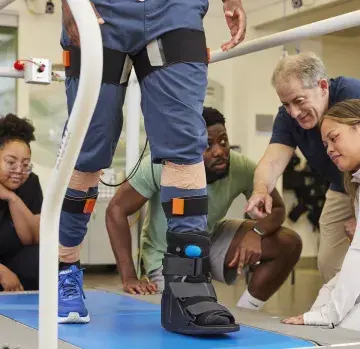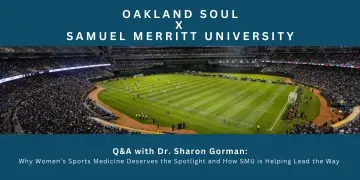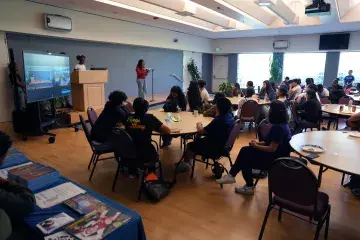SMU Passes Latino Enrollment Benchmark, Moves Closer to Diversity Goals
As the demographics of California have shifted and Latinos are now the largest ethnic group in California, the student population at Samuel Merritt University (SMU) is also growing more diverse with the number of Latino students having tripled over the past five years.
Latino students now represent more than 17 percent of students enrolled across all five SMU healthcare programs — up from just over 6 percent in 2010, according to enrollment statistics compiled by SMU’s Office of Institutional Research and Evaluation.
The encouraging growth means that SMU has met and surpassed its goal for attracting more Latino students to the University. Five years ago, the Board of Regents approved a Diversity Plan that called for 12.5 percent Latino enrollment by the end of this year.
 “I’m really elated,” said Chief Diversity Officer Shirley Strong (pictured left). “We’ve made great progress.”
“I’m really elated,” said Chief Diversity Officer Shirley Strong (pictured left). “We’ve made great progress.”
SMU is working to increase the number of Latino and African American students to help ensure that the healthcare workforce better reflects the communities where care is needed most. In communities of color, residents often lack access to preventative care and suffer from higher rates of disease than those in predominately white neighborhoods.
The number of African American students at Samuel Merritt is also on the rise, but the pace has been slower. Black students now represent just over 4 percent of the student population as compared to just below 3 percent in 2010.
“We are moving in the right direction, but we need to do more to attract African American students into the health professions,” said SMU Dean of Admission Timothy Cranford, who is working closely with the Office of Diversity and Inclusion to recruit underrepresented students. “Being visible in the communities around us will attract a more diverse population.”
SMU has increased efforts to reach out to community colleges and inform students about the science and math classes they need to take and the grades they need to achieve to pursue health science careers.
“The challenge is to get students prepared early in terms of their science curriculum so they can be competitive for our nursing and other healthcare programs,” said Strong. “Public high schools are not preparing African American and Latino students in a way that makes them competitive and students are not aware of the courses they should be taking.”
Strong said plans are also underway to get the word out about Samuel Merritt University at historically black colleges across the country.
“We want to identify people who want to serve their communities and reduce health disparities,” said Strong.
Shawna Holbrook, an admissions counselor for the SMU’s bachelor’s and master’s degree programs in nursing, said her office is intensifying its recruitment efforts by working with campus programs at community colleges that support students of color and attending dozens of transfer fairs as well as making presentations at minority nursing conferences.
Holbrook credits SMU’s pioneering Nursing Success! Seminar with diversifying the nursing applicant pool. The three-day summer seminar introduces underrepresented, prospective students to the nursing profession and is the only one of its kind offered by a Bay Area nursing school. This year, Holbrook said she has been cultivating seminar participants by staying in touch with them on Facebook and inviting them to campus events.
“The more diverse we become, the more attractive we become to minority students,” said Holbrook.
Another key feature of SMU’s outreach efforts is the President’s Ambassador Program, which provides opportunities for student leaders to publicly represent the University and discuss their personal experiences with potential students.
 Nursing student Carmen Craven (pictured right), who is part Peruvian, said the Ambassador Program encourages a diverse group of students from all three SMU campuses to get out into the community. She said she finds herself able to offer lessons learned from her own experience when she attends admissions events.
Nursing student Carmen Craven (pictured right), who is part Peruvian, said the Ambassador Program encourages a diverse group of students from all three SMU campuses to get out into the community. She said she finds herself able to offer lessons learned from her own experience when she attends admissions events.
“We speak to people who might not think they are academically ready to get into Samuel Merritt,” said Craven. “I notice that people have questions about what route I took to get into the nursing program and they feel more comfortable talking to someone who’s been through the process.”
Craven, who learned about SMU from a high school friend who graduated as a Family Nurse Practitioner, said the best recruitment tool of all may be word-of-mouth.
“When people have such a good experience at Samuel Merritt University, they persuade others to attend,” said Craven.


